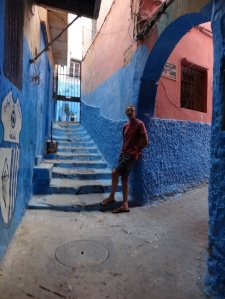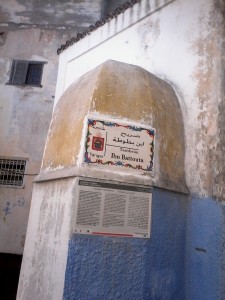The medina of Tangier is a sanitised one; no goats, no open sewers, only a few beggars and something I haven’t seen before in medinas throughout the Middle East: street names. This makes navigating a lot easier and, together with signs pointing out interesting places, makes it hard for faux guides to sell their services. Not that they don’t try: Kasbah this way, sir!
In the Medina I saw a lot of scrawny cats. At some point I stopped somewhere, trying to photograph a sleeping kitten curled up in a corner, but I hesitated as I wasn’t sure if it wasn’t actually dead.
Among the audible routine of the everyday life in a moslim country is the call for prayer. Five times a day the muezzin taps the microphone, clears his throat and starts hollering. It seems a boring job and I don’t understand why they keep repeating the same message because nobody really listens to hear what’s new this time, as there’s nothing new since the 8th century. The first prayer of the day, or dawn prayer, is usually in the middle of the night and includes the debatable phrase: Prayer is better than sleep.
One day I cycled to the Atlantic Coast to the Caves of Hercules. The caves were closed so I sat down on the grass at the side of the road. I was just getting out some bread and fruit when a guard told me to leave the grass because it belonged to a palace of the king. The king was not actually in this palace, but apparently he didn’t like people sitting on his grass, even if the grass was outside the palace walls, and he himself wasn’t even anywhere near the palace. I could, however, sit on the grass on the other side of the road. On a rock. In the blistering sun.
Traffic around Tangier was appalling.
Tangier is famously the city of the traveller Ibn Battuta who was born here.
The tomb of Ibn Battuta was easily found as it was just around the corner of my guesthouse. While not as well known in the Western world as his famous contemporary, Marco Polo, he was arguably more widely travelled than his Venetian counterpart. You might have heard of him as a crater on the moon is named after him.
The sign on the tomb doesn’t explicitly say it’s the grave of the famous explorer, but rather a memorial and I don’t believe there is any evidence that it is his actual final resting place. A little below it, is a little tap serving water to the neighbourhood, which is only useful information if you’re thirsty.
Like Marco Polo, his travels are not without controversy. When I travelled in Egypt I first stumbled on his journal and was surprised to find out that Ibn Battuta described the pyramids as being conical in shape. This is even more remarkable given the fact that Ibn Batutta visited Cairo no less than five times…
One of the reasons Ibn Battuta is revered in the Arabic speaking world is his religious fervour. The great traveller was a Judge by profession and he wrote with pious condemnation about the customs of the lands he travelled through, that is, if they were not in agreement with his religion. This didn’t stop him from marrying with a great many women during his exploits as he did for example during his visit to the Maldives where he married no fewer than four women. According to Battuta this was normal practice for crews of ships calling on these islands, only to divorce them when they left again. Nothing wrong with that. Says Ibn Battuta.


